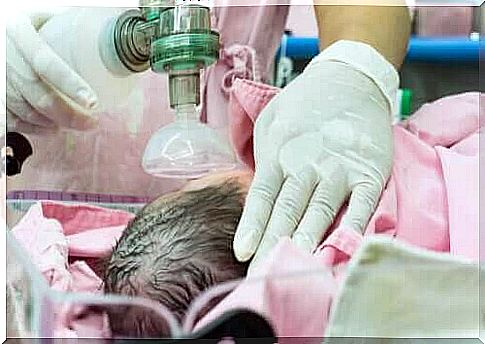Respiratory Diseases In Newborns

Young children are especially prone to certain diseases. Therefore, early detection is important in order to diagnose and treat problems such as respiratory diseases in newborns.
According to the study “Respiratory Disorders in the Newborn”, respiratory problems are quite common in newborns. This may seem surprising. Respiratory diseases in newborns require early treatment, as they can be life-threatening. In this article, we introduce you to some of the most common and how they can be treated.
Respiratory diseases in newborns

Respiratory diseases in newborns are also called neonatal respiratory diseases. Some of them can come through infections or birth defects. To discuss some of the most common respiratory diseases in newborns, we will focus on a study of Dr. Cesar Alberto Orozco.
Interstitial lung disease (ILS)
The first of respiratory diseases in newborns can affect the entire lung or parts of it. The problem is that it creates a permanent disturbance of the partitions of the alveoli, which causes the air to spread. This happens spontaneously and usually in newborns who receive breathing therapy. Sometimes it happens in infants who weigh far below normal weight.
The most common treatment is to place the newborn on the side (the side with the affected lung) to cause it to collapse and thereby heal. Doctors can also introduce a tracheal tube through the neck and down to the healthy lung so that the other can heal.
Pneumothorax
This respiratory disease is usually more common in premature babies. The problem is that air gets trapped in the area around the bronchi, which puts pressure on the airways.
The trapped air often escapes to areas between the lung and the chest wall, which are called the pleural space. When this happens, the newborn’s skin often gets a bluish tinge, which is called cyanosis.
Experts see this disease as acute as the risk of death is quite high. The solution is usually to introduce a catheter into the baby’s breast to extract the air that has entered the pleural space.
Transient tachypnoea

The third of the mentioned respiratory diseases in newborns lasts less than 24 hours. As in the previous case, the baby’s skin may become bluish. It happens because of the fluid that is still in their lungs.
Although the baby eliminates a large portion of the fluid when they breathe, premature babies or children born by caesarean section may have trouble expelling it.
The common treatment is monitoring and giving the child oxygen. Rapid breathing is a typical symptom of this disease. During treatment, the child should receive fluids and nourishment through the blood.
Other respiratory diseases in newborns
We have now looked at three very different respiratory diseases in newborns. However, there are many other problems that newborns can be affected by, and here comes a brief summary of other types of respiratory diseases.
- Congenital tracheomalacia. Here the trachea does not develop properly, making it weak and limp. Infants often make a noise during breathing with this problem. It usually gets better within 18 months.
- Congenital bronchiectasis. Here the airways dilate due to an infection or inhalation of a foreign body. It often causes complications, and the goal of treatment is to eliminate the infections (which often recur). In most cases, the damage is permanent.
- Pulmonary hypoplasia. This alters the development of the lungs by inhibiting the branching of airways and arteries. It causes breathing problems that often lead to death. However, it is a rather rare disease.
- Congenital pneumonia. Here there is inflammation in the lung tissue, which makes the death toll so high. However, early treatment with antibiotics can avoid this.
Here you got an overview of some of the respiratory diseases that newborns can be affected by. An early diagnosis is important for doctors to treat them. The medical staff will in this case perform the necessary tests to find the best treatment.









